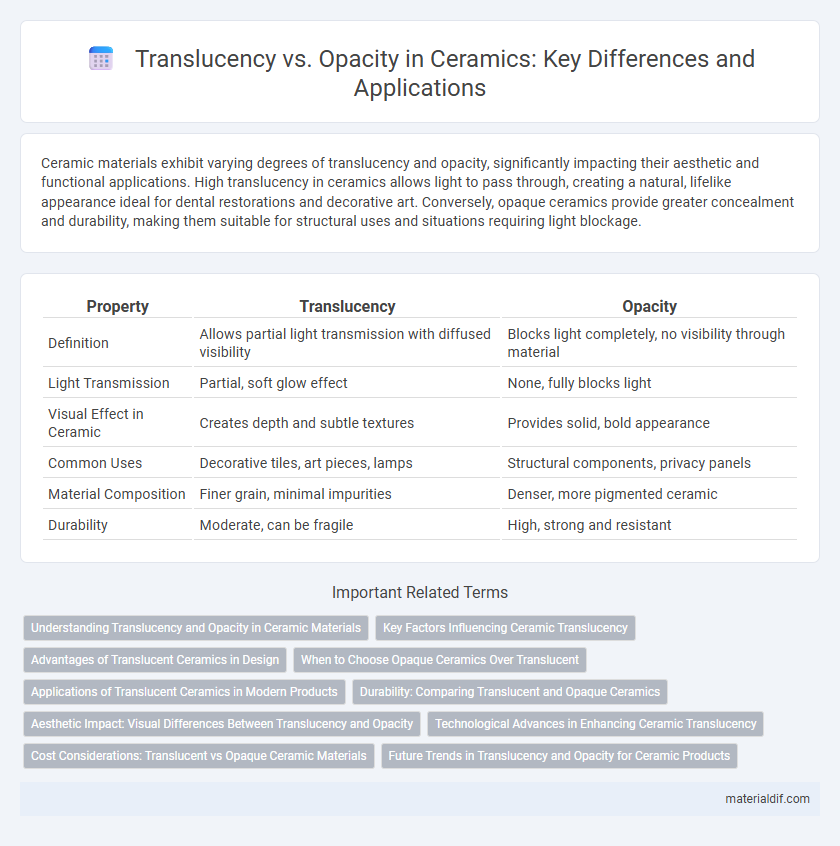Ceramic materials exhibit varying degrees of translucency and opacity, significantly impacting their aesthetic and functional applications. High translucency in ceramics allows light to pass through, creating a natural, lifelike appearance ideal for dental restorations and decorative art. Conversely, opaque ceramics provide greater concealment and durability, making them suitable for structural uses and situations requiring light blockage.
Table of Comparison
| Property | Translucency | Opacity |
|---|---|---|
| Definition | Allows partial light transmission with diffused visibility | Blocks light completely, no visibility through material |
| Light Transmission | Partial, soft glow effect | None, fully blocks light |
| Visual Effect in Ceramic | Creates depth and subtle textures | Provides solid, bold appearance |
| Common Uses | Decorative tiles, art pieces, lamps | Structural components, privacy panels |
| Material Composition | Finer grain, minimal impurities | Denser, more pigmented ceramic |
| Durability | Moderate, can be fragile | High, strong and resistant |
Understanding Translucency and Opacity in Ceramic Materials
Translucency in ceramic materials refers to the ability of light to pass through the material while being diffused, creating a glow-like effect, whereas opacity indicates complete light blockage, resulting in a solid, non-transparent appearance. Factors influencing translucency include particle size, glass phase content, and firing temperature, which affect the ceramic's microstructure and light scattering properties. Understanding the balance between translucency and opacity is crucial for applications in dental ceramics, lighting fixtures, and decorative art, where aesthetic and functional properties must align.
Key Factors Influencing Ceramic Translucency
Ceramic translucency is primarily influenced by factors such as particle size, crystalline structure, and material composition, which determine light transmission and scattering. Smaller particle sizes and a uniformly amorphous phase enhance translucency by reducing light scattering, while larger crystals or porosity increase opacity. The degree of sintering and the presence of impurities also critically affect the optical properties, impacting the final aesthetic and functional performance of ceramic materials.
Advantages of Translucent Ceramics in Design
Translucent ceramics offer enhanced aesthetic appeal by mimicking the natural light diffusion found in materials like porcelain and glass, resulting in more lifelike and visually pleasing finishes. Their ability to transmit light improves depth perception and creates subtle shadows, which adds dimension and softness to architectural and product designs. Furthermore, translucent ceramics contribute to energy efficiency by allowing controlled light passage, reducing the need for artificial lighting in interior applications.
When to Choose Opaque Ceramics Over Translucent
Opaque ceramics are ideal when concealing underlying tooth discolorations or metal dental posts, ensuring a uniform appearance in restorative dentistry. Their higher light-blocking properties prevent dark shades from affecting the final restoration color, making them suitable for posterior crowns and bridges where aesthetics are less critical. Choosing opaque ceramics enhances masking ability and structural strength in cases demanding durability over natural translucency.
Applications of Translucent Ceramics in Modern Products
Translucent ceramics, characterized by their ability to transmit light while diffusing it, are increasingly applied in modern products such as smartphone displays, LED lighting covers, and advanced medical implants. Their unique optical properties enable enhanced aesthetics and functional benefits, including improved brightness and biocompatibility in dental prosthetics and lighting technologies. Innovations in materials like alumina and zirconia have expanded the use of translucent ceramics beyond traditional opaque counterparts, driving advancements in electronics, healthcare, and architectural design.
Durability: Comparing Translucent and Opaque Ceramics
Translucent ceramics exhibit lower opacity but often sacrifice some durability compared to opaque ceramics, which are denser and more resistant to wear and impact. The microstructure of opaque ceramics typically contains fewer defects and higher crystallinity, enhancing their mechanical strength and longevity in harsh environments. While translucent ceramics excel in aesthetic appeal due to their light transmission properties, opaque ceramics remain the preferred choice for applications demanding maximum durability and resistance.
Aesthetic Impact: Visual Differences Between Translucency and Opacity
Translucency in ceramics allows light to penetrate the surface, creating depth, subtle shadows, and a lifelike glow that enhances aesthetic appeal. Opacity blocks light, resulting in solid, uniform coloration that emphasizes shape and texture more than depth. The visual difference significantly influences design choices, with translucency offering a delicate, ethereal appearance and opacity providing bold, striking contrast.
Technological Advances in Enhancing Ceramic Translucency
Technological advances in enhancing ceramic translucency have revolutionized dental and architectural applications by enabling materials to mimic natural aesthetics more closely. Innovations such as nano-structuring and advanced sintering techniques improve light transmission through ceramics, reducing opacity without compromising strength or durability. These developments facilitate the production of high-performance ceramics that combine superior translucency with mechanical robustness, expanding their functional and aesthetic use.
Cost Considerations: Translucent vs Opaque Ceramic Materials
Translucent ceramic materials typically cost more due to advanced processing techniques required to achieve their light-permitting properties, making them ideal for applications demanding aesthetic appeal and natural light diffusion. Opaque ceramics are generally more affordable, offering durability and strength for functional uses without the expense of translucency-enhancing treatments. Balancing cost considerations involves evaluating the specific application needs, where translucent ceramics justify higher prices for visual effects, while opaque ceramics serve budget-conscious projects prioritizing performance.
Future Trends in Translucency and Opacity for Ceramic Products
Future trends in ceramic products emphasize enhanced translucency through advanced nano-engineering and controlled crystallization, enabling materials with superior light diffusion and aesthetic appeal. Innovations in opacity focus on integrating multi-layered composites and dopants to achieve tailored light-blocking properties while maintaining structural integrity. These developments drive applications in dental ceramics, architectural facades, and electronic substrates, balancing translucency and opacity for optimized performance.
Translucency vs Opacity Infographic

 materialdif.com
materialdif.com